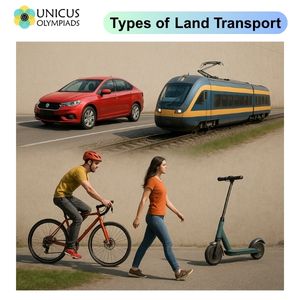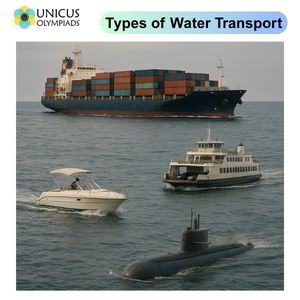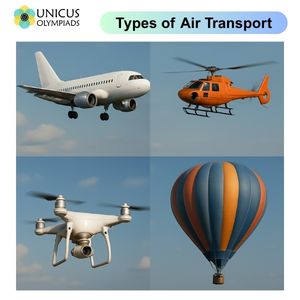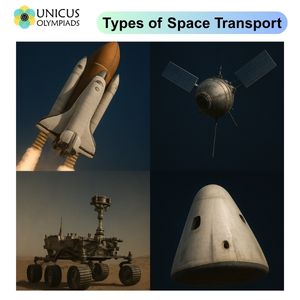What Are Types of Transport on Land, Water, Air, and Space with Unique Examples?
Transportation is essential for moving people and goods from one place to another. Over the centuries, various types of transport have evolved, catering to different needs, environments, and technological advancements. In this article, we will explore the major types of transportation across land, water, air, and space, with unique examples that showcase how these modes of transport have shaped human history and future possibilities.
Land Transport
Land transport includes all types of vehicles and methods used to travel across the Earth's surface. This form of transportation is crucial for daily commuting, trade, and connecting regions across large distances. It includes a wide variety of vehicles, ranging from the traditional to the modern.

Types of Land Transport
- Automobiles: Cars, buses, trucks, and motorcycles are the most common vehicles used for personal and commercial transportation on roads.
- Trains: Trains are large vehicles that run on tracks, commonly used for long-distance travel and transporting goods.
- Cycling: Bicycles are an eco-friendly mode of transport used for short-distance travel.
- Walking: Walking is the simplest and most natural form of transport, often used for short distances.
- Electric Scooters: These are battery-powered scooters that have become increasingly popular in urban areas for short-distance commuting.
Examples of Land Transport
- Bullet Trains: High-speed trains like the Shinkansen in Japan have revolutionized land travel, reaching speeds of up to 320 km/h (199 mph).
- Electric Cars: Tesla's electric cars are an example of land transport that focuses on reducing carbon emissions while providing efficient mobility.
- Tram Systems: Cities like Amsterdam, Vienna, and Melbourne use trams, which provide eco-friendly public transport for city dwellers.
Water Transport
Water transport is vital for moving goods and passengers across oceans, rivers, lakes, and seas. It is one of the oldest and most efficient modes of transportation, especially for international trade. Water transport can be divided into shipping, ferries, and recreational boating.

Types of Water Transport
- Ships: Large vessels designed for ocean travel and freight transportation.
- Boats: Smaller watercraft used for short-distance travel, fishing, or leisure activities.
- Ferries: Boats or ships used to carry passengers, cars, and goods across bodies of water.
- Submarines: Underwater vessels designed for deep-sea exploration, military use, or leisure cruises.
Examples of Water Transport
- Cargo Ships: Cargo ships are the backbone of international trade, carrying goods between continents. The Ever Given, one of the largest container ships in the world, gained attention when it blocked the Suez Canal in 2021.
- Ferries: Countries with extensive ferry systems, such as those in Scandinavia, use ferries to transport passengers and vehicles between coastal towns and islands.
- Submarines: Nuclear submarines are used by military forces globally for defense purposes and underwater exploration.
Air Transport
Air transport includes all types of vehicles that travel through the air, such as airplanes, helicopters, and drones. It is the fastest mode of transport for long distances and is essential for international travel, trade, and defense.

Types of Air Transport
- Airplanes: Airplanes are the most common form of air transport for both commercial and private use, traveling at high speeds and altitudes.
- Helicopters: Helicopters are used for short-distance air travel, emergency services, and aerial surveys.
- Drones: Unmanned aerial vehicles (UAVs) used for a variety of tasks, including delivery, surveillance, and photography.
- Hot Air Balloons: A unique form of air transport used for leisure activities and tourism, offering panoramic views of landscapes.
Examples of Air Transport
- Commercial Airplanes: Boeing 747 and Airbus A380 are examples of large commercial airplanes that can carry hundreds of passengers across continents at speeds of 900 km/h (560 mph).
- Helicopters: Medical helicopters provide fast transport for patients from remote areas to hospitals in emergencies.
- Private Jets: Gulfstream jets are a popular choice for business travel, offering speed and luxury for executives and high-profile individuals.
Space Transport
Space transport refers to the vehicles and technologies used to travel beyond Earth's atmosphere, facilitating exploration, communication, and scientific research. Space transport has advanced significantly in recent years, with both government agencies and private companies contributing to the development of space travel technologies.

Types of Space Transport
- Spacecraft: Spacecraft are vehicles designed to travel in space, often used for exploration and scientific research. These include crewed spacecraft, such as space shuttles, and uncrewed ones, such as rovers and satellites.
- Space Probes: Unmanned vehicles sent to explore distant planets, moons, and stars, collecting data about our solar system and beyond.
- Space Tourism: With the rise of private companies, space tourism is becoming a reality, with spacecraft designed for civilian space travel.
Examples of Space Transport
- SpaceX Dragon: SpaceX has developed the Dragon spacecraft, which has been used to transport cargo to the International Space Station (ISS) and is set to be used for crewed missions to Mars.
- NASA Space Shuttle: NASA's Space Shuttle program, active from 1981 to 2011, was one of the most significant achievements in space transport, allowing reusable spacecraft to carry astronauts to low Earth orbit.
- Blue Origin New Shepard: Blue Origin’s New Shepard is a suborbital spacecraft designed for space tourism, capable of carrying passengers to the edge of space and providing brief weightlessness experiences.






